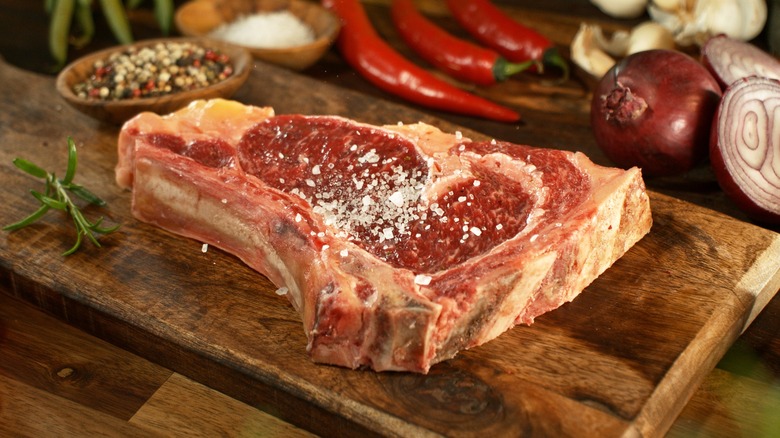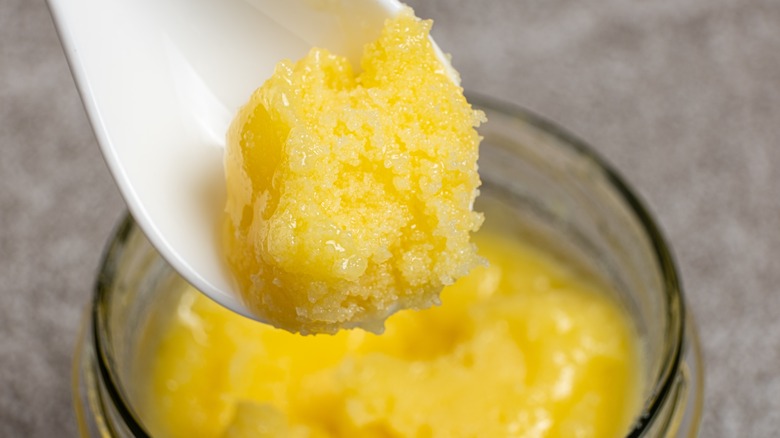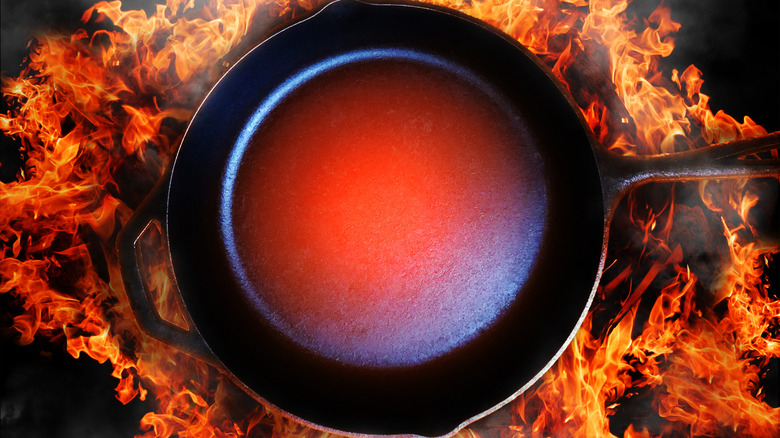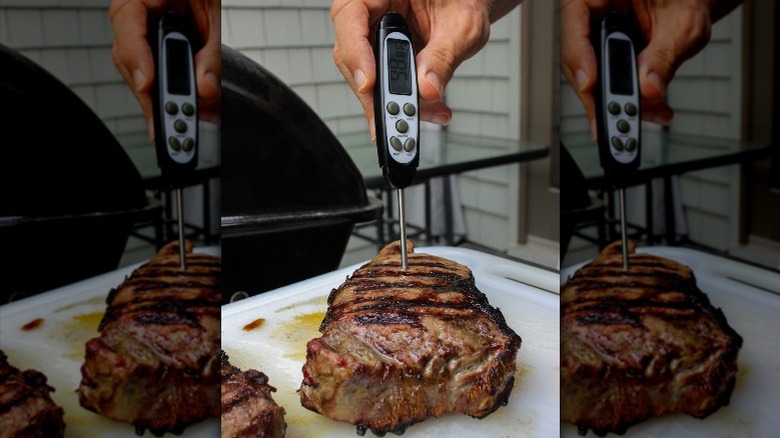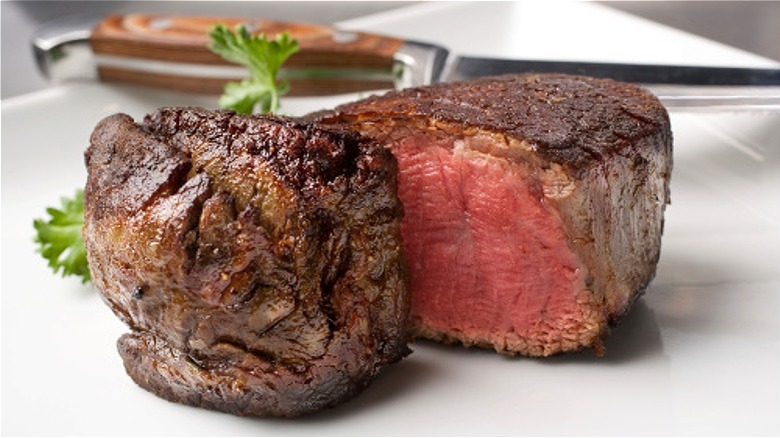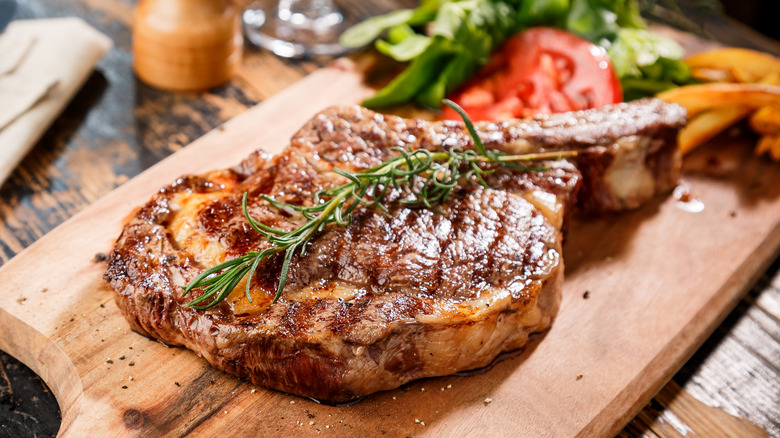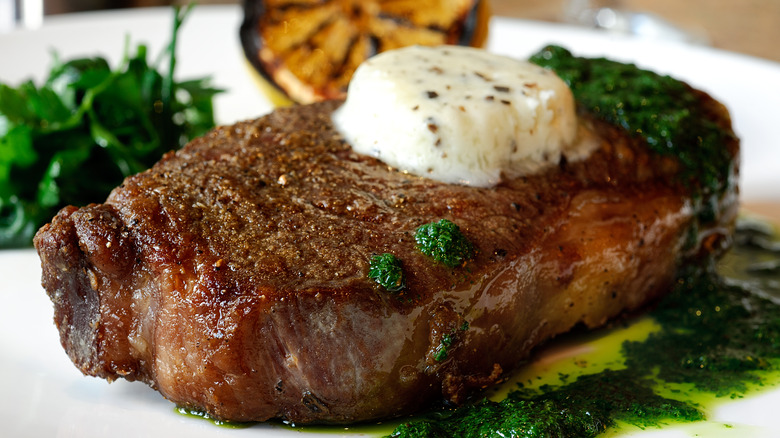13 Tips For Cooking Restaurant-Quality Steak At Home, From A Pro Chef
There's a reason why restaurant steak tends to taste better than a steak you cook at home. From prep to finish, professional chefs master the art of cooking a cut of meat perfectly using sight, sound, and skills they learned in culinary school. I spoke with chef Adrianne Calvo, owner and chef at Chef Adrianne's Vineyard Restaurant & Bar and host of the Searching for Maximum Flavor podcast to find out how to cook restaurant quality steak at home. After opening the Miami restaurant more than 15 years ago when she was only 22 years old, she has since accumulated multiple restaurant awards.
One of the first things Calvo learned in culinary school was to know when steak was done cooking just by looking at it. She says, "You can tell by the way the juices shine through the char, how closely knit the grain of the steak looks, and by its overall tightness. Lastly, it's all about the feel." Achieving restaurant quality steak means becoming one with the steak. But we can help you do that. Calvo takes us through the top tips for creating an award-winning piece of meat.
1. Bring your steak to room temperature
A good, noteworthy steak starts with bringing your chosen cut up to room temperature before cooking it, according to chef Adrianne Calvo. "Don't cook a cold steak," she warns. You want to make sure your steak rests for a while at room temperature, so it has a chance to cook evenly when it hits the heat, either in a pan or on the grill. No matter what type of steak cut you opt for, the U.S. Department of Agriculture advises not to leave raw meat out of the fridge for more than two hours (and no more than an hour if the temperature is 90 degrees Fahrenheit or more). But this should be plenty of time for the majority of steak cuts. Be sure to fully thaw frozen meat in the refrigerator to avoid spoiling.
Allow steak to warm up from the cold temperature of a fridge to reduce the risk of cold spots and thus, uneven cooking. This helps prevent the exterior of the meat from cooking faster than the interior while keeping the overall cooking time to a minimum, which decreases the chance of your steak drying out from being on the heat too long. Tempering your steak (the process of gradually changing temperature from cold to room), also enhances the deep crust you can get from a good sear.
2. Pat your steaks dry
Water and oil don't mix, especially when the oil is hot. So, if water meets hot oil in a pan, the water expands, which spreads the oil. This causes the oil in your pan to spatter and spit as the heat works to turn the water into steam, potentially giving you a burn from flying oil. Too much water on your steak — noted by small droplets sitting on the top of your steak — halts the Maillard reaction, which is what gives you that beautiful, caramelized crust on the outside. Instead, a wet steak in hot oil simply becomes steamed, while simultaneously making a mess. Thus, how you prep your steak is just as important as how you cook it.
Once your steak cut has come up to room temperature, chef Adrianne Calvo recommends patting it dry. "Using a paper towel, pat dry all the blood and excess moisture," she tells us. Having a dry exterior on your steak "ensures the best contact with your grill, flat top, or iron skillet," she says. That close contact not only helps with more even cooking, but it means the heat isn't spending all its energy burning off the extra water instead of browning your meat in order to create that perfect sear.
3. Use the right type of fat
It's important to choose the right type of fat when you're cooking with high heat, which is typically noted as a temperature of 400 to 450 degrees Fahrenheit. Chef Adrianne Calvo says to use an oil or fat that has a high smoke point. Why's that? Smoke point indicates the point when the fat begins to burn and break down, which isn't what you want. You want your fat to remain stable when you cook your meat in it. Hence the reason you want to go for a fat that features a high smoke point, such as avocado oil or clarified butter. Avocado oil has a smoke point of about 520 degrees Fahrenheit and clarified butter has a smoke point of 450 degrees.
At what point you add oil or fat to your pan matters just as much as the fat you choose to use in order to ensure you achieve the browned exterior on your steak from the Maillard reaction. This reaction happens when the sugars in the meat kiss the heat. You want to get the oil hot so that your steak immediately touches high heat. But it's best to heat your pan first before adding your oil. This reduces the risk of burning the fat before you get a chance to sear your steak.
4. Use either a stainless steel or cast iron pan
Grilled steak can be a thing of beauty, but it can also be trickier to accomplish than a pan-seared steak. Chef Adrianne Calvo recommends using a stainless steel or cast iron pan to help you get a quality steak similar to what restaurants serve. These types of pans are known for their even heat distribution, which helps steak cook the same from end to end. This is unlike grill grates, which Calvo says provide an uneven heat distribution. After all, no one wants a cut of steak that's raw on one end and overcooked on the other. This is why Calvo prefers a flat-top grill or pan when cooking steak.
All cuts of steak can be cooked via stainless steel or cast iron, according to chef Calvo. Cuts like ribeye, New York strip, or filet mignon are among some of the most popular cuts for pan-searing. If you choose a piece of meat that still features the bone, keep this in mind when you do cook it. The bone could keep the meat from coming in direct contact with the hot pan, affecting the sear.
5. Get your pan super hot
The number one trick to cooking quality steak like a restaurant chef is to "use the right pan and get it very hot," says chef Adrianne Calvo. "Whether you're using a flat top or grill, make sure it's very hot." How hot is very hot? As hot as you can get it using a high flame, which is typically around 450 to 500 degrees Fahrenheit. This high temperature is why you want to use an oil or fat that features a high smoke point. "Do not use medium heat for searing steaks," she tells us. "Great crusts only come from high temperatures."
High heat is what helps spark the Maillard reaction to come into play. When your room temperature steak is placed in the super hot pan, the stark contrast in temperature prompts the meat's sugars to be caramelized by the piping hot fat. That's how the magic happens. And that's how restaurant quality steak is made.
6. Season your steak right before cooking
There's a lot of debate about when and how to season a piece of meat. Some cooks argue for using seasoning during prep time, others call for seasoning meat after you've cooked it while it's resting, and some say to season it right before you cook it. Chef Adrianne Calvo believes in seasoning steak right before you're about to put it in the pan. And she suggests keeping your seasonings simple. Calvo likes to use Kosher salt and freshly ground pepper for her steaks, seasoning them right before she puts them in the pan. It's worth noting that despite Calvo's suggestion, pepper at too large of a grind can burn at searing temperatures, giving a bitter finish to your steak. Thus, you should look to use finely ground pepper as your seasoning.
Though steak that is seasoned with just salt (and maybe pepper) is the best way to truly enjoy the rich taste of a beefy cut, sometimes you're looking for a little something more to complement your meat. There are a number of great steak recipes that include a range of flavoring options from sweet to spicy. Steak can be marinaded, breaded, sauced, or topped to create a variety of different dishes to keep your palate happy.
7. Do not puncture your steaks or handle too frequently
One of the biggest mistakes a lot of people make is how they handle the steak while they're cooking it, according to chef Adrianne Calvo. Unless you're looking to tenderize your steak, you want to handle it with care. You've gone through the proper steps to prep your prized cut of steak, so the last thing you want to do is mishandle it. Do not reach for a fork. Chef Calvo emphatically warns against using any kitchen utensil that could puncture or put holes in your steak. She strongly advises to only use tongs when handling meat.
While you want to use a utensil that's gentle when picking up your steak, chef Calvo also warns against flipping your steak repeatedly in the pan. After your steak is placed in the pan, flip it only one time during cooking and just let it heat through undisturbed after achieving a sear. An overworked steak can become tough. If you're worried about your steak sticking to the pan, fear not. As meat heats, the muscles begin to contract; there will be a moment when the steak separates itself from the pan, and that's when you should flip.
8. Use a meat thermometer to gauge internal temperature
Professionally trained chefs should be able to tell when a steak is done cooking just by looking at it and restaurant quality steak should be cooked precisely to your desired doneness. Chef Adrianne Calvo tells us that during her training, she wasn't allowed to use a thermometer after her first week of culinary school. Instead, she learned what qualities to look for in a properly cooked steak. But for those of us who didn't go to culinary school, a meat thermometer is a must-have item for determining the desired internal doneness of your steak.
The internal temperature that you're striving for depends on how you like to eat your steak. Chef Calvo starts with a final temperature of 135 degrees Fahrenheit to reach medium rare and then adjusts her cooking time based on a customer's preference. An internal temperature of 140 to 145 degrees Fahrenheit for cooking steak is considered medium and 150 to 155 degrees Fahrenheit is medium well. Insert the thermometer roughly halfway through the steak, in its thickest part, to take a reading.
9. Know what your steak should look like when it's done
Of course, you can use a meat thermometer to determine when your steak is finished cooking, but if you really want to acquire a restaurant quality steak at home, it would benefit you to learn what your steak should look like when it's done. As chef Adrianne Calvo mentioned to us previously, noticing just how the steak shines or how the grain looks is key to knowing when it's done. But she also tells us that you can determine this by feel. So if you don't have a meat thermometer handy, there's a trick you can use.
"If you lightly touch your thumb to your index finger and use your other hand to touch the palm near your thumb, that's how a rare steak feels," chef Calvo says. The feel is somewhat spongy but not too soft. Furthermore, she explains, "Touch your thumb to your middle finger, and that's medium rare. As you go up in fingers, you go up in temperature. By the time you reach your pinky, that's how a well-done steak feels."
How long you cook your steak largely depends on whether you want it rare, medium-rare, or medium. But if you're looking to duplicate restaurant steak, it's typically cooked to medium-rare. Chef Calvo says, "I use the same cooking method for all cuts. High heat, bit of oil that has a high smoke point, and flat top, stainless steel, or cast iron pan. Sear on high for a few minutes to create a great crust."
10. Let your cooked steak rest before cutting
Just as you let steak rest before seasoning and cooking it, you need to let your steak rest after cooking it, says chef Adrianne Calvo. Though it may be tempting to dive right into a juicy steak when it's hot off the pan or grill, you may not have that juicy interior if you don't let it rest first. "Allow your steak to rest for 10 minutes before slicing or serving to ensure all the juices remain intact," Calvo advises. When a cut of meat is cooked, the muscles contract, pushing moisture out to the surface. But as it rests, the muscles relax, pulling back in some of that lost moisture.
The reason you can cut right into your steak when you're served at a restaurant is the rest period happens from the time your steak is done cooking to the time your plate gets to the table. When you rest steak at home, you need to pay attention so you're still able to bite into a nice, warm steak and not a cold one. 10 minutes is the average time it takes, and you'll quickly know if this was long enough. If your first cut results in a bunch of liquid on your plate, wait another 5 minutes. Don't rush the process and you'll have a quality steak to enjoy.
11. Top hot steak with butter for added umami
During the time it takes for your steak to rest is the perfect time to top it with fresh flavors. Searing steak requires such high temperature that most herbs and spices will just go up in flames and either scorch the piece of meat, turn into an off-putting burnt taste, or just completely disappear as though you didn't season the steak at all. It's best to wait until your steak has come off the heat to top it with your desired additions. The residual heat coming off the meat gently enhances herbs, spices, sauces, or other delicate ingredients.
Chef Adrianne Calvo shares with us her favorite way to top steak: "I love a good maître d' butter, [which is a French compound butter,] and caramelized onions, and a white truffle finish if I'm feeling over the top!" Butter is a popular choice for topping steak since its rich creaminess matches the slightly acidic profile of red meat. Plus, it slowly melts over your resting steak as you eat it. If you'd like to make your own buttery sauce, check out these four ingredients to take your steak to another level.
12. For high-end results, cook a tomahawk ribeye
For a show-stopping, restaurant-style cut of meat, consider trying your hand at cooking chef Adrianne Calvo's favorite steak cut: a tomahawk ribeye. Among one of the largest cuts out there, typically weighing anywhere from 3 to 4 pounds, a tomahawk features the ribeye cut with a super long bone — the shape being reminiscent of an actual tomahawk axe. But as far as the steak goes, the meat is coveted for its marbling and thickness. "It has a good amount of fat, juiciness, and [is] very tender," chef Calvo says. "The bone on the tomahawk is a stunner!"
As stunning as the tomahawk is, it can be a challenge to cook. But that doesn't mean it's impossible, either. If you're new to the tomahawk ribeye, the best way to cook it is using one of chef Calvo's preferred methods: a cast iron or stainless steel flat top or skillet. Since it's so large, you need a flat surface so the bone fits flush to the cookware.
13. Consider your sides
For many people, including chef Adrianne Calvo, all they need is a good appetite to enjoy a steak. You know how the old saying goes, "hunger makes the best sauce." But if you like more than just steak on your plate, consider your sides and how they best complement your meat. Chef Calvo shares with us, "Roasted greens like Brussel [sprouts] or broccoli are my favorite!" But a number of other foods pair well with steak as well, potatoes being one of the most common choices.
The reason why potatoes marry steak on a frequent basis is the light, earthy savoriness that offsets the touch of acidity steak contributes. Plop on some butter and the creaminess brings it all together. We might warn you, however, not to smother your hard-earned, restaurant-quality steak in too many other ingredients that you miss out on what makes steak one of the most wanted items on a menu.

